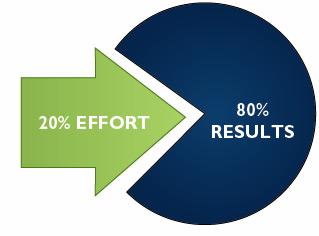 I’m a huge Seth Godin fan, always in awe of the plethora of wisdom he manages to pack into one pithy post. I save them up, building a collection I can draw upon for inspiration as life, personal and professional, pushes in.
I’m a huge Seth Godin fan, always in awe of the plethora of wisdom he manages to pack into one pithy post. I save them up, building a collection I can draw upon for inspiration as life, personal and professional, pushes in.
Recently I looked back at What’s in the box? The point of the post is to make us question our quest for perfection and all the needless worrying we put into imagining everything that can possibly go wrong. Godin encourages us to worry less; just open the box and see what’s in it. Good to consider. Yet this presumes there’s a filled box to be opened.
When we’re in reactive or firefighter mode, we must open the box. The contents must be dealt with, generally with some urgency. So, definitely, perfectionism gets in the way. There’s simply no time for it! But, what about when we’re in proactive mode, building our own projects?
A Greater Challenge Than Opening the Box
Filling and delivering it! This means coming up with useful, delightful, meaningful content your recipient will consider a true gift. Once you’ve got a nicely filled box — a good gift — it’s time to deliver so the donor’s “feel good” can begin. Alas, this is where the concept of “done enough” vs. “overdone” can rear its ugly head.
Imagine This: You plan to send some cookies to your college sophomore. You make a batch of gorgeous macarons. Then you worry they’re too fancy. The next day, before putting them in a shipping box, you decide to add some chocolate chip since they’re ‘safe’. The next day you decide, as long as you’re bothering to ship these, you’ll add some brownies and oatmeal because then there’s some to share with roommates. The next day you realize it’s almost Valentine’s Day, so they’ll probably expect some heart-shaped sugar cookies. Now you’re getting into the “project-ness” of this endeavor, and decide you’ll make a few more kinds so it’ll be a really spectacular presentation! Great fun, yes… but, what has happened to the macarons by the end of the week?
The Old Stuff Gets Stale
While it’s true sometimes things are not ready for prime time, the reverse is also true. Things can get past their prime. And sometimes in truly silly, unforgiveable, decidedly non-user-friendly ways.
Consider This: Multiple staff have access to update your website, but no one is charged with responsibility to take down outdated information. Your new event coordinator builds a page promoting your upcoming Gala, but when visitors search your website to find “events” they’re taken to a page for last year’s Walkathon. There’s even a button where they can register – except it happened 18 months ago!
The key to success is finding balance.
Between old and new.
Between good and perfect.
Between moving forward and getting stuck.
Between Done Enough and Overdone
I want to challenge you to make perspective your friend. Never lose it! Always go back to the “why,” so you remember why you took on any given project. If you’ve done enough to achieve your purpose, stop.
- Hit “send.”
- Go live with the web page.
- Send the appeal to the printer.
- Call the donor and ask for a meeting.
- Purchase the software.
- Publish the newsletter.
- … and so on.
Don’t Do What My Sister Did: While in college, she took a sculpture class. She’d created a beautiful clay bust for her final project. She’d worked on it in the studio for weeks. The night before it was due, her professor stopped by around 9:00 p.m. and told her how wonderful it was. She had an “A” already. But she didn’t think it was perfect. She stayed and worked some more… into the wee, wee hours… fine-tuning the jaw, redoing the nose, fixing up the plane of the brow… until her professor found her there, asleep at the work table, early the next morning. The bust was completely destroyed. She’d remade it and remade it, growing increasingly tired, and making more and more mistakes until she ultimately lost her perspective and her way.
Stop Being a Perfectionist
You’ll complete more projects (i.e., fill and deliver more boxes) in less time.
If you’re the type for whom ‘good enough’ suffices, you don’t need to read the rest of this post. If you’re the type who strives for perfection… wordsmiths every word… agonizes over every verb, adjective and adverb… rereads, edits and rearranges copy until it seems just right… thinks if you only got 98% on an exam you failed… then this post is for you!
I’ll confess I used to be a 100 percenter: I had a need to be like Mary Poppins – “practically perfect in every way.” Guess what I’ve recently discovered? Being Mary Poppinsesque is exhausting! Even Mary understood the sense of modifying perfection with “practically.” Above all else, Mary was very, very sensible.
Is it sensible to suffer from ‘term paper syndrome’? I do! Somewhere along the way I inherited an imperative to be “thorough.” I’d often revise website copy or funding proposals ad nauseum, because I felt I didn’t have enough well-researched, referenced content. I know folks who mean to post to their blog regularly, but don’t because the several half-finished articles they have aren’t (in their humble opinion) quite ‘ready for prime time.’ I have clients who mean to send out monthly email newsletters or campaigns, but don’t because of so-called writers’ block.
Everything Doesn’t Have To Be A+ Work
Where’s the sense in not doing anything because you fear it won’t be the best? Nothing comes from nothing. And nothing will come from your drafted appeals, emails, newsletter articles, web pages, social media posts, strategic plans, policies and procedures — unless you turn them into delivered content.
Consider This True Story and Life Lesson: Years ago, I wrote a grant report for a funder. My boss read it and edited it heavily. Alas, I’d already sent it off. I felt terrible. Her edits mostly consisted of switching out adjectives; yet her changes did make the report better. Still… I thought I’d done a good job, and I’d met the deadline. She chewed me out, however, and I suffered. About a month later I attended a professional meeting where the same foundation’s program officer happened to be the speaker. He was talking about good reports and proposals vs. bad ones. To make his point, he talked about one wonderful report he’d recently received that hit all the points he looked for and really did an effective job. Yup, you guessed it. He was talking about the miserable report I’d submitted, without my boss’s edits. From that day forward I knew that while A+ was still a goal, A and A- were just fine.
Don’t Give Anything 100%; It’s All You’ve Got
 Voltaire is credited with saying “the perfect is the enemy of the good.” The takeaway? Perfectionism is contrary to satisfactory competence. Why? Because we can’t put 100% into everything. It’s all we’ve got. A quest for perfection will lead, inevitably, to diminishing returns.
Voltaire is credited with saying “the perfect is the enemy of the good.” The takeaway? Perfectionism is contrary to satisfactory competence. Why? Because we can’t put 100% into everything. It’s all we’ve got. A quest for perfection will lead, inevitably, to diminishing returns.
The Pareto Rule of 80/20 reminds us it commonly takes 20% of our time to complete 80% of our task. The last 20% takes 80% of the effort. Whoa! The Marines have something they call the 70% solution (i.e., it’s better to decide quickly on an imperfect plan than to roll out a perfect plan when it’s too late).
Do What My Son Did: My son intuitively understood these principles in high school. He got straight B’s (very hard for a Mom who got straight A’s), but he was more than content. Why? He explained it to me thusly: “Mom, I spend 40 minutes doing my homework. Kids who get A’s spend 4 hours. I don’t see the point. Bs are fine. Is it more about learning, or grades? I can spend the rest of my time learning about things that interest me.” How’d he become so wise?
Being Exact Pales Beside Being Expressive
It’s the thought that counts. If you don’t get your thoughts out for fear of imperfection, your best intentions do not matter. Folks want to hear from you. Consistently. They’d prefer to hear from you regularly with interesting, good enough posts, newsletters and calls to action than to hear from you once in a blue moon with a long, meticulously researched, word-smithed article. They don’t want a term paper. They want something simple, direct, engaging and timely. Something from your heart, demonstrating they can count on you.
Being Perfect Pales Beside Being Dependable.
When you don’t overdo it, and relax into your work, you’ll find you’re much more able to connect. No one wants a stuffy term paper writer. They want a comfortable, relatable experience with you. No one cares if you could have used a stronger adjective somewhere along the way. What your constituents care about is building a kind of relationship that includes them as a member of your community.
Commit to Finishing at “Good Enough”
Fill your box and get it delivered so it’s worth something to someone now. Otherwise, it’s nothing more than an unfinished project. And one that may seem less and less worth finishing over time.
One of the problems with disruptive technology and information overload is how easy it is to go on endlessly, losing sight of the original goal. The pursuit of information for information’s sake may seem noble, but in the context of your work does it really serve a noble end?
Next Steps
Ask yourself:
- In what way do I keep my potential “gift boxes” empty?
- What things am I putting off because I don’t have time to perfect them?
- In completing my project (aka filling my box) would every one of the goodies inside have to be perfect, or could the overall collection – some stuff “good enough” and maybe one or two things “great” – be just swell?
- How might I refresh my perspective on a project to move it forward?
- What’s one thing I can do tomorrow to move an unfinished project to the front burner?
Don’t get stuck inside the box. Let it see daylight and do its job!
Want to Work More Effectively All the Time?
 Working smart means taking time to develop the mindset and support infrastructure, to assure you’re on the path to success. Do you have clarity on what you hope to accomplish? Are there pre-conditions to success not in place? Are key players on the same page? Do you show donors what’s in it for them to affiliate with you? What value do you offer? Why is it better than what anyone else is offering?
Working smart means taking time to develop the mindset and support infrastructure, to assure you’re on the path to success. Do you have clarity on what you hope to accomplish? Are there pre-conditions to success not in place? Are key players on the same page? Do you show donors what’s in it for them to affiliate with you? What value do you offer? Why is it better than what anyone else is offering?
These questions and more are addressed in The 7 Clairification Keys To Unlock Your Nonprofit’s Fundraising Potential. Through a series of clairifying worksheets and individual + group exercises, this 42-page guide offers fresh insights so you can think strategically about achieving desired outcomes. Stop mindlessly tweaking last year’s plan, and dig deep into why you’re doing these things. Clairify your (1) values; (2) stories; (3) brand; (4) social channels; (5) support constituencies; (6) engagement objectives, and (7) resources + systems.
All Clairification products come with a no-questions-asked 30-day 100% refund guarantee. If you’re not happy, I’m not happy.
Macaron image courtesy of Pixabay.





